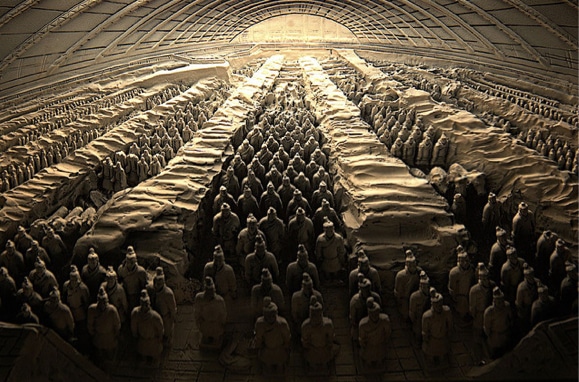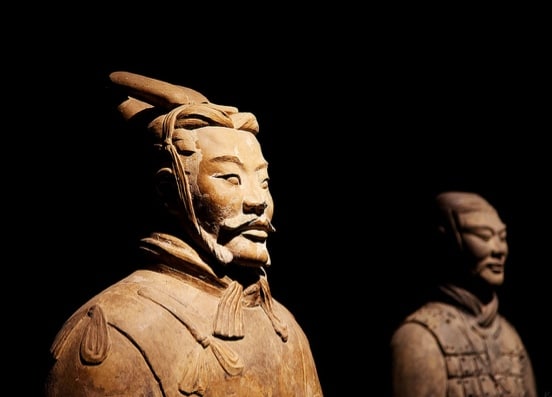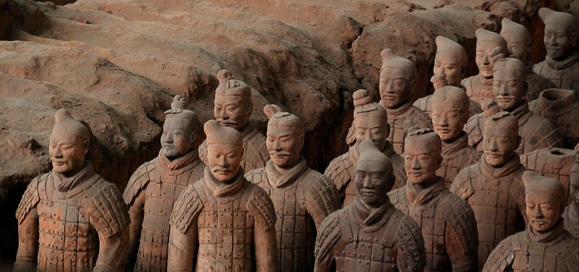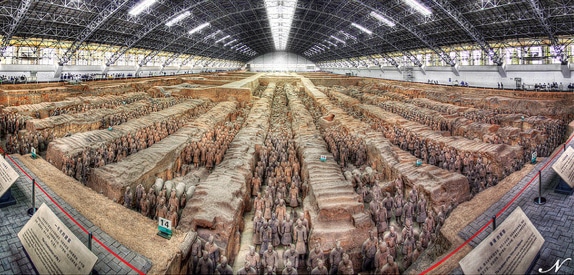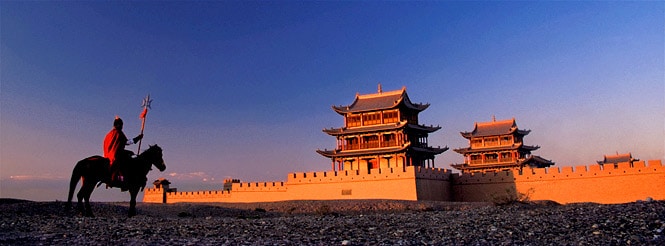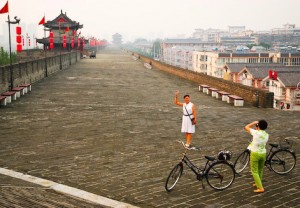The Terracotta Army in Xi’an, aka the Terracotta Warriors and Horses, is a huge collection of life-size terra cotta sculptures in battle formations, reproducing the mega imperial guard troops of Emperor Qin Shi Huang (259 – 210BC), the first emperor of the first unified dynasty of Imperial China
In 1974, farmers digging a well near Xi’an, China accidentally uncovered one of the world’s most spectacular architectural finds. Surprise — a life-sized terracotta soldier! But wait there’s more…much to their amazement, archeologists unearthed an entire Terracotta Army of some 7,000 warriors, chariots, and horses.
The Terracotta Warriors — each with different facial features, weapons, and poses — were commissioned by the first emperor of China, Qin Shi Huang Di, to guard his tomb before he died in 210BC. Although no one knows how much remains undiscovered, the entire necropolis is estimated to cover over 20 square miles (56 sq. km).
And talk about a thankless job. It’s estimated that it took a staggering 700,000+ workers nearly 40 years to complete construction. Their reward? To keep the location of the tomb secret from grave robbers, the emperor had all of the workers buried alive! And I’m guessing they didn’t get overtime pay either.
Today, tourists flock to Xi’an (pronounced “Shee-ahn”, sometimes spelled “Xian”) mainly to see the Terracotta Army but there’s a lot more to do and see in this pleasant city, especially for fans of history. It’s easy to walk or bike around the city itself, but your best bet is to join a tour to see the outlying tourist attractions (including the Terracotta Warriors which are 20m/30km east of Xi’an).
Today, Xi’an’s status as a hot tourist destination has brought a flood of rural migrants into the city looking for work (and has also resulted in begging and pollution problems). Still, the city is considered to be one of China’s most pleasant cities as well as the most popular city for foreign students to study Chinese outside of Beijing.
Xi’an is also a great place for buying souvenirs, paintings and antiques (both real and fake). From Beijing, you can either take a one-hour flight or an overnight train (about 12 hours).
Terracotta Warrior Facts & History
Although the brutal rule of Emperor Qin Shi Huang Di was short, he left China with two of its most famous tourist attractions: The Terracotta Warriors and the Great Wall of China 1.0. Oh yeah, he also unified China and standardized writing and currency throughout the country. Not too shabby for a heartless egomaniac.
Although no records exist of terracotta soldiers, they were built over two thousand years ago. So far, three rectangular vaults have been found and are today protected by giant hangars (for a long while, photography was prohibited although they’ve since loosed up the rules, as long as you don’t use a flash).
Xi’an served as capital of the Shaanxi province for more than 1100 years and 13 imperial dynasties, including some of China’s most important dynasties. In fact, the fertile plains of Shaanxi is considered ground zero of early China civilization, the axis of power around which the Chinese universe revolved.
The history of the region goes waaay back. Neolithic tribes established the first permanent settlements in China more than 6,000 years ago. Xi’an — known then as Chang’an (City of Eternal Peace) — is believed to be the largest and most prosperous city in the world at its peak. During the Sui and Tang dynasties, the city was the eastern terminus of Silk Road — linking China to central Asia and Europe — and considered the center of the civilized world in Asia.
As the destination of thousands of Silk Road traders, the population was unusually diverse, with people from around world, including Muslims (you’ll still find a large Muslim population and many mosques).
Because the Tang was a tolerant dynasty, a creative explosion of different cultural influences were allowed to mix and blossom. The result was that Tang period was a golden age in China for religion as well as Chinese music & art — including ceramics, calligraphy, painting and poetry.
Top Xi’an Attractions
- Take a stroll around Xi’an’s towering 40 foot high City Walls, one of the Xi’an top tourist attractions. Or better yet, rent a bike (near South Gate of wall) and take in the cityscapes on the 500 year old walls in about an hour.
- Considered one of best museums in China, the Shaanxi History Museum houses over 100,000 relics unearthed in the province.
- Originally constructed in 742AD, The Great Mosque—a blend of Chinese and Arabic architecture — is one of the oldest and best-preserved Islamic mosques in the country.
- Grab a snack and some gifts in the markets in the fascinating Muslim Quarter, home to some 60 thousand Muslims (which actually isn’t that big of a population compared to the 10 million Han Chinese in the city).
- Located about 2 hours southwest of Xi’an, the Panda Reserve at Zhouzhi in the Qingling Mountains is home to eight non-Kung Fu pandas (and one baby)—in addition to golden monkeys, black bears and leopards.
- Take a day trip to Huashan (75m east of Xi’an) for some fresh air to see one of China’s five holy Taoist mountains — a mist-covered mountain home to several temples a cave dedicated to Laozi, author of the Tao Te Ching.
If you’re planning a trip to Xi’an, you’ll want to do your research on the best ways to travel between Beijing and Xian.

